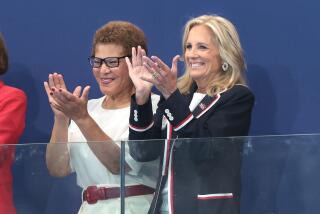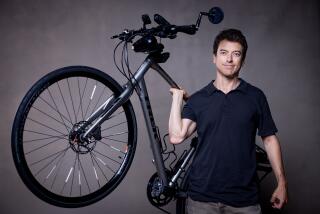Make the Going Easy, Mayor
Los Angeles voters rank traffic up there with education and crime as problems they want the winner of the May 17 mayoral election to fix, according to a Times poll released last week. In a region where the average person spends 93 hours a year idling, gridlocked streets do more than pollute air and fray nerves. They keep cops from speeding to crime scenes and ambulances from reaching hospitals in time. They make workers late for jobs and kids late for school. They steal time from soccer games, parent-teacher conferences and family dinners. They diminish the draw of museums and theaters.
Today’s Opinion section asked experts in the field to tackle traffic. It’s a topic we’ll return to throughout the year in hopes of helping residents -- and whoever they choose as mayor -- find a path out of gridlock.
Mayor James K. Hahn is a realist who makes promises he knows he can (mostly) keep, like filling potholes and installing left-turn signals. City Councilman Antonio Villaraigosa, Hahn’s challenger in the May runoff, is a dreamer who wants to expand Los Angeles’ subway and light-rail system into one a New Yorker might envy.
Villaraigosa chides Hahn for thinking too small. Hahn accuses Villaraigosa of promising too much. Los Angeles needs a mayor who can do both the small things and rally support for the big ones.
What can a mayor do, given that streets, freeways, buses and rail fall under various regional, state and federal jurisdictions, and that doing just about anything requires big infusions of federal and state money?
One of the biggest ways a mayor can influence traffic is by encouraging smarter development that cuts down on the need to drive. This involves planning, zoning and jawboning that encourages developers to put apartments and offices next to public transit routes and to cluster jobs, homes, schools and malls together. It also means convincing NIMBYs not to shoot such plans down.
On the regional level, the mayor should be leading the effort to get state lawmakers to release at least some of the Proposition 42 gas-tax money that voters three years ago earmarked for transportation projects, but that Sacramento for the last two years has diverted to the state budget crisis. He should take the lead in finding alternative ways to move goods at the Los Angeles and Long Beach port complex. He should push for a regional airport system that, while still modernizing Los Angeles International Airport, distributes the load to the city-owned airports in rapidly growing Palmdale and the Inland Empire.
Finally, the mayor can use the bully pulpit to urge residents to do their part to fight congestion. We like author and urban planner William Fulton’s suggestion that the mayor regularly use buses and mass transit. He should also push carpooling. Southern California cars average 1.12 passengers per vehicle. Raising that average to just 1.3 passengers per vehicle, according to Metropolitan Transportation Authority Director Roger Snoble, would eliminate congestion in Los Angeles. Yes, eliminate.
Los Angeles needs a mayor, then, who not only says what he can do to end congestion but is brave enough to ask car-loving Angelenos to be a part of any solution.
More to Read
Sign up for Essential California
The most important California stories and recommendations in your inbox every morning.
You may occasionally receive promotional content from the Los Angeles Times.










